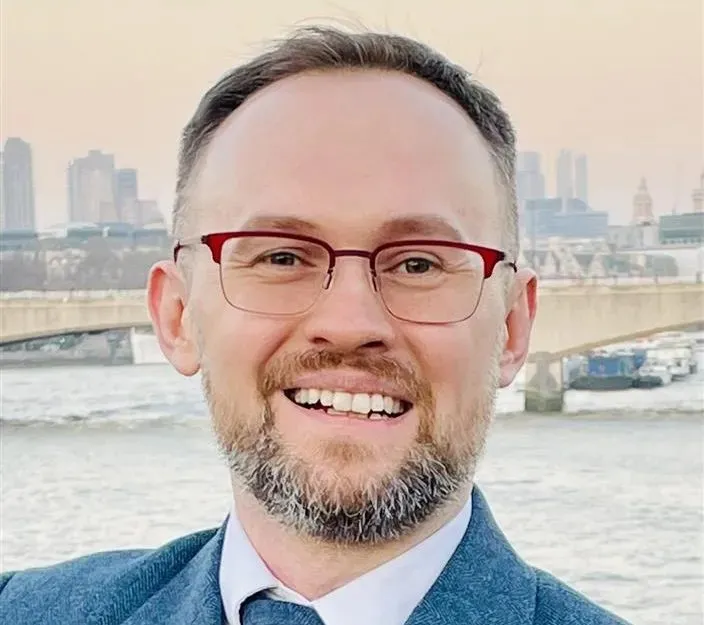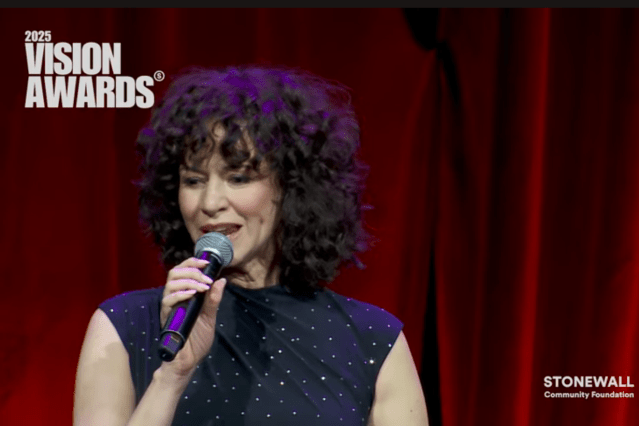Story of the Week: Dots, the New Scenic Design Collective, Is Changing the Game
The mysterious four-letter firm is becoming ubiquitous in the New York theater.
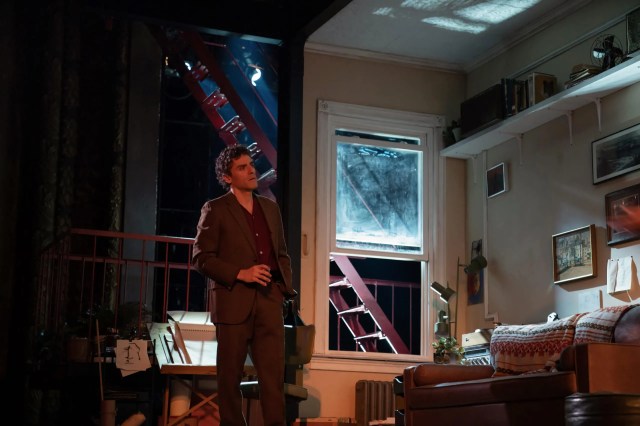
(© Julieta Cervantes)
In the span of a week, I attended three shows with the same set designer: Public Obscenities at Soho Rep, The Sign in Sidney Brustein’s Window at BAM, and Dark Disabled Stories at the Public Theater all feature sets by the scenic design collective that calls itself “dots.”
They’re taking over, but who is behind dots? And what exactly is a scenic design collective? I asked them about it for this Story of the Week.
Who is “dots”?
Santiago Orjuela-Laverde, Andrew Moerdyk, and Kimie Nishikawa are three set designers who met during grad school at NYU. Early in the pandemic, when work was scarce, they decided to combine forces and operate as a collective. They’re like Power Rangers armed with drafting pencils.
This wasn’t something any of them anticipated, nor did the typically lonely path of an early-career designer incentivize forming a collective — especially for people operating at the pleasure of America’s immigration bureaucracy.
Nishikawa is from Japan, Moerdyk is from South Africa, and Orjuela-Laverde is from Colombia. Following school, all three were able to obtain O-1B visas for “individuals with an extraordinary ability in the arts.” Securing this kind of visa isn’t easy and requires a mountain of evidence proving just how extraordinary you are. It’s the meritocracy on steroids, adjudicated by the federal government.

“It’s exhausting because your life in the States is quantified by your work credits. It’s about making sure your name is on things so you can submit that with your visa application,” says Nishikawa, who spoke about working for free as an assistant to a more established designer right after graduation. “All I got was a thank you e-mail. I felt really used and I promised myself that I would never do that to an assistant.”
This is the paid-in-experience ethos with which so many creatives are uncomfortably familiar: You work for free to build your résumé in hopes of making connections and securing a paid position…eventually. But in the case of the three members of dots, those credits could also mean the difference between staying in the country and having to sashay away. When you’re applying for (or renewing) a visa, every program and poster with your name on its counts, which begs the question…
Why would they give up individual credits to form a collective?
“That was once of the first things we discussed. What is the benefit of doing it alone? Just so your name can be on the poster?” says Moerdyk, pointing out how this individual glory can easily turn into a singular nightmare for a designer who is overworked and under-resourced. “If I can’t keep up, it’s my name on the line.”
Orjuela-Laverde likens dots to an umbrella that shields individual human designers from the downpour. “When a problem comes to dots, the umbrella receives it first. We discuss it internally, so we’re not alone in finding a solution, and it gives us some time and distance.” All three agree that this result in better work and saner designers.
The umbrella metaphor also applies to the harsh economics of the theater. In all but the most successful commercial productions, a designer will be paid a flat fee for their work, typically distributed in one-third installments. Every designer has a horror story about not being paid in a timely manner. This can make planning important life decisions (buying a house, having children) all but impossible.
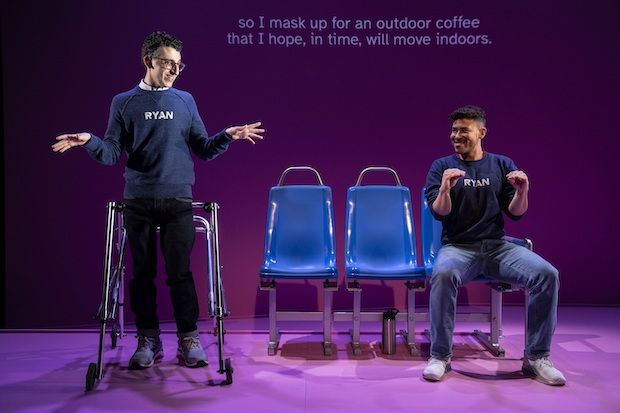
(© Joan Marcus)
While dots earns fees comparable to what an individual designer would make on any given production, having three designers allows them to take on more work, including lucrative commercial work. And rather than accepting the feast-or-famine model by which so many freelance designers operate, dots pools all fees and distributes regular salaries to its three partners, providing a level of stability that is rare for anyone working in the theater.
Essentially, they have created a scenic design agency that operates similar to (but perhaps more equitably than) an architectural firm (Moerdyk previously worked as an architect). Nishikawa is clear-eyed about the impetus to embrace this radical (for the theater) new way of doing business: “The industry is not going to change how they pay artists. So we had to change. And because we control our account, we can ensure timely payment to our associates.”
In a country that so often prioritizes the rights of corporations over people, these three newcomers have safeguarded their financial wellbeing by becoming a corporation.
What are the benefits of hiring a collective like dots?
Three for the price of one is the obvious selling-point. Dots brings a level of manpower to a production that individual designers cannot. “One thing that we are really mindful of is that the director will know who will be there for tech and what is expected,” says Nishikawa. “The last thing we want is the director feeling abandoned.”
At the same time, the three lead designers can draw on one another’s strengths and specialized skills to operate more efficiently on a broader spectrum of work. “When we do commercials, Santi takes the lead on doing the mood boards and talking to the director. And Andrew has the digital skills to make 3-D renderings quickly,” says Nishikawa. “I take that and I do the 2-D drafting package for the shop. We never really talked about that division of labor, but it happened organically.”
Orjuela-Laverde adds, “Between the three of us, we’ve also increased our skills as a group.” Rather than jealously guarding their trade secrets, they share their knowledge with one another. That makes dots a design collective whose abilities will only grow over time, one that is already creating a very sophisticated level of work.
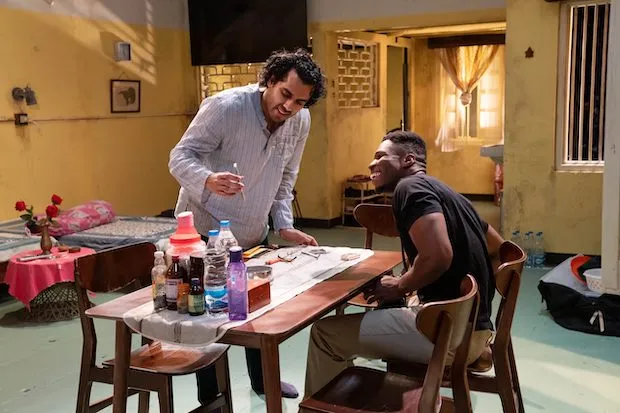
(© Julieta Cervantes)
Is the work really that good?
It is. The set for Public Obscenities, on the tiny stage of Soho Rep., suggests a sprawling family compound with the bustling streets of Kolkata just beyond; the way it plays with the light from a far upstage window is absolutely gorgeous. At BAM, Sidney Brustein’s apartment seems to hover over the stage, offering the realism of a period Greenwich Village apartment while also making room for the magic of the second act. And the set for Dark Disabled Stories, complete with a ramp and ample surfaces on which to project supertitles, is the most accessible I’ve ever encountered. Its glittering fuchsia façade captures Ryan J. Haddad’s gay fabulism while also foregrounding the venue in which very real and disturbing shit goes down for disabled New Yorkers: the bus (Dark Disabled Stories really should be required viewing for all MTA executives).
This summer, dots is taking on Puccini’s Madame Butterfly for Cincinnati Opera at Music Hall, one of the largest opera houses on earth. “I had so much trouble initially getting into that story, and the revelation for me was that it has nothing to do with Japan,” says Nishikawa. “It’s all the fantasy of an Italian composer. So we took that as a concept: What if this wasn’t real?” Expect high fantasy as only the opera, and dots, can provide.
It’s surprising that the idea of a design collective hasn’t emerged sooner in the American theater scene. The impulse to join forces in the face of a common struggle is one that the founders of this country would likely recognize. Centuries later, the three immigrant entrepreneurs of dots are revolutionizing scenic design and creating jobs for American associates in the process — they’re open to expanding operations. I hope more young designers follow their example.

